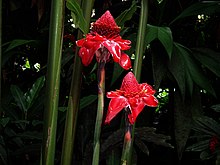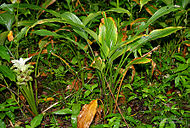Zingiberaceae
| Ginger family Temporal range:
| |
|---|---|

| |
| Red torch ginger (Etlingera elatior) | |
| Scientific classification | |
| Kingdom: | Plantae |
| Clade: | Tracheophytes |
| Clade: | Angiosperms |
| Clade: | Monocots |
| Clade: | Commelinids |
| Order: | Zingiberales |
| Family: | Zingiberaceae Martinov[2] |
| Type genus | |
| Zingiber Boehm.
| |
Zingiberaceae (
Evolution
The earliest known fossils of the family belong to the Campanian age and are from the genera Spirematospermum in Germany,Tricostatocarpon and Striatornata in Mexico, and Momordiocarpon in India.[5][6] Spirematospermum chandlerae from the Santonian of North Carolina was previously classified in the Zingiberaceae, but more recent studies support it belonging to the Musaceae.[7][1]
Description
Members of the family are small to large herbaceous plants with distichous leaves with basal sheaths that overlap to form a pseudostem. The plants are either self-supporting or
Some genera yield essential oils used in the perfume industry (Alpinia, Hedychium).
Taxonomy
| Cladogram: Phylogeny of Zingiberales[8]
| ||||||||||||||||||||||||||||||||||||||||||||||||
|
Phylogenetic tree of the family
Subdivisions
| Zingiberaceae |
| ||||||||||||




- Subfamily Siphonochiloideae
- Tribe Siphonochileae
- Tribe
- Subfamily Tamijioideae
- Tribe Tamijieae
- Tribe
- Subfamily Alpinioideae
- Tribe Alpinieae
- Adelmeria
- Aframomum - grains of paradise
- Alpinia - galangal
- Amomum
- Aulotandra
- Cyphostigma
- Elettaria - cardamom
- Elettariopsis
- Etlingera
- Geocharis
- Geostachys
- Hornstedtia
- Lanxangia
- Leptosolena
- Plagiostachys
- Renealmia
- Siliquamomum
- Vanoverberghia
- ×Alpingera F. Luc-Cayol (Alpinia × Etlingera) - intergeneric hybrid
- Tribe Riedelieae
- Tribe Alpinieae
- Subfamily Zingiberoideae
- Tribe Zingibereae
- Boesenbergia
- Camptandra
- Caulokaempferia
- Cautleya
- Cornukaempferia
- Curcuma - turmeric
- Curcumorpha
- Distichochlamys
- Haniffia
- Haplochorema
- Hedychium
- Hitchenia
- Kaempferia
- Kedhalia
- Laosanthus
- Myxochlamys
- Nanochilus
- Newmania
- Parakaempferia
- Pommereschea
- Pyrgophyllum
- Rhynchanthus
- Roscoea
- Scaphochlamys
- Smithatris
- Stadiochilus
- Stahlianthus
- Zingiber - ginger
- Tribe Globbeae
- Tribe Zingibereae
Distribution
The Zingiberaceae have a pantropical distribution in the tropics of Africa, Asia, and the Americas, with their greatest diversity in South Asia.
References
- ^ a b "Zingiberales". www.mobot.org. Retrieved 2023-06-18.
- hdl:10654/18083.
- .
- JSTOR 24107978.
- S2CID 51909421.
- S2CID 231875495.
- .
- ^ Sass et al. 2016.
Bibliography
- Sass, Chodon; Iles, William J.D.; Barrett, Craig F.; Smith, Selena Y.; Specht, Chelsea D. (21 January 2016). "Revisiting the Zingiberales: using multiplexed exon capture to resolve ancient and recent phylogenetic splits in a charismatic plant lineage". PeerJ. 4: e1584. PMID 26819846.
External links
- List of Indian medicinal plants from Biodiversity of India
- Abstracts from the Symposia on the Family Zingiberaceae
- A New Classification of the Zingiberaceae from the Third Symposium on Zingiberaceae
- Zomlefer, W.B. Flowering Plant Families. The University of North Carolina Press. 1994.
